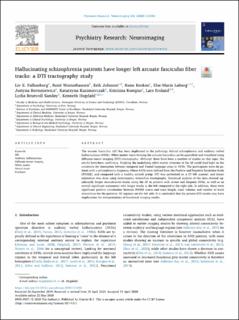| dc.contributor.author | Falkenberg, Liv E. | |
| dc.contributor.author | Westerhausen, René | |
| dc.contributor.author | Johnsen, Erik | |
| dc.contributor.author | Kroken, Rune Andreas | |
| dc.contributor.author | Løberg, Else-Marie | |
| dc.contributor.author | Beresniewicz, Justyna | |
| dc.contributor.author | Kazimierczak, Katarzyna Anna | |
| dc.contributor.author | Kompus, Kristiina | |
| dc.contributor.author | Ersland, Lars | |
| dc.contributor.author | Sandøy, Lydia Brunvoll | |
| dc.contributor.author | Hugdahl, Kenneth | |
| dc.date.accessioned | 2021-03-12T12:15:16Z | |
| dc.date.available | 2021-03-12T12:15:16Z | |
| dc.date.created | 2020-06-01T14:33:57Z | |
| dc.date.issued | 2020 | |
| dc.identifier.issn | 0925-4927 | |
| dc.identifier.uri | https://hdl.handle.net/11250/2733163 | |
| dc.description.abstract | The arcuate fasciculus (AF) has been implicated in the pathology behind schizophrenia and auditory verbal hallucinations (AVHs). White matter tracts forming the arcuate fasciculus can be quantified and visualized using diffusion tensor imaging (DTI) tractography. Although there have been a number of studies on this topic, the results have been conflicting. Studying the underlying white matter structure of the AF could shed light on the constrains for interaction between temporal and frontal language areas in AVHs. The participants were 66 patients with a schizophrenia diagnosis, where AVHs were defined from the Positive and Negative Syndrome Scale (PANSS), and compared with a healthy control group. DTI was performed on a 3T MR scanner, and tensor estimation was done using deterministic streamline tractography. Statistical analysis of the data showed significantly longer reconstructed tracks along the AF in patients with severe and frequent AVHs, as well as an overall significant asymmetry with longer tracks in the left compared to the right side. In addition, there were significant positive correlations between PANSS scores and track length, track volume, and number of track streamlines for the posterior AF segment on the left side. It is concluded that the present DTI results may have implications for interpretations of functional imaging results. | en_US |
| dc.language.iso | eng | en_US |
| dc.publisher | Elsevier | en_US |
| dc.rights | Navngivelse 4.0 Internasjonal | * |
| dc.rights.uri | http://creativecommons.org/licenses/by/4.0/deed.no | * |
| dc.title | Hallucinating schizophrenia patients have longer left arcuate fasciculus fiber tracks: a DTI tractography study | en_US |
| dc.type | Journal article | en_US |
| dc.type | Peer reviewed | en_US |
| dc.description.version | publishedVersion | en_US |
| dc.rights.holder | Copyright 2020 The Author(s). | en_US |
| dc.source.articlenumber | 111088 | en_US |
| cristin.ispublished | true | |
| cristin.fulltext | original | |
| cristin.qualitycode | 1 | |
| dc.identifier.doi | https://doi.org/10.1016/j.pscychresns.2020.111088 | |
| dc.identifier.cristin | 1813377 | |
| dc.source.journal | Psychiatry Research: Neuroimaging | en_US |
| dc.identifier.citation | Psychiatry Research: Neuroimaging. 2020, 302, 111088. | en_US |
| dc.source.volume | 302 | en_US |

